The results of international encirclement against the militant group, the Islamic State and the future challenges
Ikuzo Kobayashi, President of NPO Salaam Association
From the Autumn issue of the electronic Salaam Quarterly Bulletin, No.15, August 2015
One year has transpired since ISIS exalted a caliph and declared establishment of the Islamic State (IS) on June 29, 2014. The declaration was made on the first day of Ramadan and Abu Bakr al-Baghdadi himself delivered a sermon on the first Friday prayers in Ramadan. The emergence of the “caliph” during the Friday prayers at a mosque in Mosul, the second largest city of Iraq, was a dramatic debut of IS in the Islamic society.
Shortly after the start of Ramadan this year, simultaneous terrorist attacks occurred in three countries (1) (four countries) on June 26. Although those terrorist attacks in three countries are still under investigation, it is clear that the attacks were carried out with instructions or under influence of IS because IS posted their audio message urging Muslims “to attack enemies and become a martyr during Ramadan” on the Internet.
The international encirclement against IS is examined here.
The situation of terrorist attacks in three countries
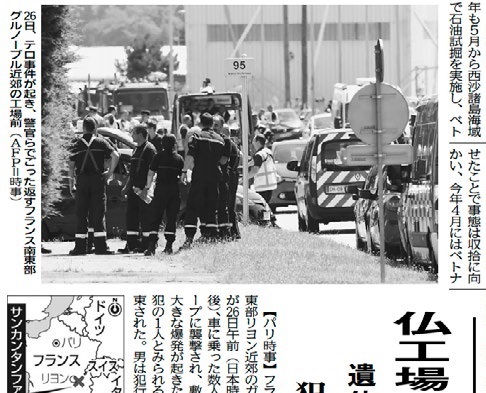
Japanese newspapers dated June 27 reported on terrorist attack in France which took place on June 26 at a factory near Grenoble, southeast part of France. In the photo policemen and others overcroweded in front of the factory.
1) The attack at a gas factory in the suburb of Lyon in south eastern France: A suspect called Yassin Salhi (35) drove a car into a gas factory and caused a big explosion. A decapitated body of the suspect’s employer (54) was found near the car and the victim’s head was covered with two flags relating to Islam. The brutal act of decapitation is reminiscent of the execution method by IS. According to French Interior Minister Bernard Cazeneuve, the suspect was under surveillance by the authority for some time for radicalization influenced by Islamic extremism. According to local media reports, the suspect is refusing to give a detailed statement, and determination of his motive is expected to be difficult.
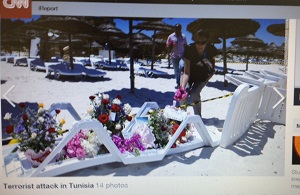
People lay flowers on the beach in front of Hotel Riu Imperial Marhaba, in the coastal city of Sousse, Tunisia on Saturday, June 27. Gunmen killed at least 38 people at site.(CNN)
2) The attack at a resort hotel in Sousse in central Tunisia: Tunisian student Saif Al-Deen Al Rezgui from the town of Gaafour opened fire on tourists with a gun hidden in a beach parasol, and was shot on site. Prime Minister Habib Essid announced that 38 people were killed. The number of victims exceeded 20 victimes including some Japanese killed in the shooting attack at a museum in Tunis in March. Someone in the name of IS claimed responsibility for the attack on Twitter.
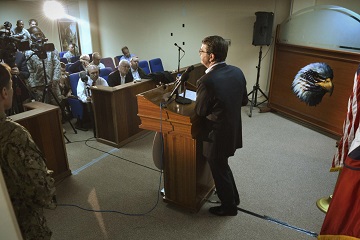
U.S. Defense Secretary Ash Carter holds a press conference after meeting with senior commanders attending a regional security conference on Camp Arifjan, Kuwait, Feb. 23, 2015.
3) The suicide attack at a Shia mosque in Kuwait: A attacker, named Fahad Al-Gabbaa of Saudi Arabian nationality, in a suicide vest blew himself up inside a Shia mosque during Friday prayers, killing 27 people participating the prayers and wounded more than 200. The Kuwaiti authority arrested a few people who are connected to the suspect. A militant group called Islamic State of Najd (a central plateau of the Arabian Peninsula) which carried out terrorist attacks in Saudi Arabia in May claimed responsibility for the attack. It justified the attack, saying that the mosque was trying to spread Shia ideology among Sunnis.
Coalition of the Willing led by the United States

Theirs were the faces that stood out in the chaotic helicopter evacuation off the Sinjar Mountains.Tears streamed down the cheeks of 15-year-old Aziza Hamid and her 17-year-old sister. U.S. President Barack Obama ordered targeted airstrikes last week, partly to protect the Yazidis and others fleeing ISIS. He also ordered humanitarian airdrops.(CNN, August 20, 2014)
While the wisdom of the total withdrawal of the U.S. troops from Iraq in December, 2011 carried out by President Obama is in question, he sent military advisors to help Iraq fight the Islamic State, carried out aerial bombings by drones and formed the Coalition of the Willing including Arab and Gulf countries in 2014. It was in response to the request from the Iraqi national government and Iraqi Prime Minister al-Abadi.
Aerial bombings in Syria were initially a limited one under the pretext of rescuing Yazidis, Christian minority in August last year. Although the United States denies cooperation with the Assad regime of Syria, she notified Syrian government about the start of aerial bombings. The Assad regime stated that it was ready for cooperation to fight international terrorism and presented a posture to seek improvement of the relationship with the United States.
International encirclement against the Islamic State
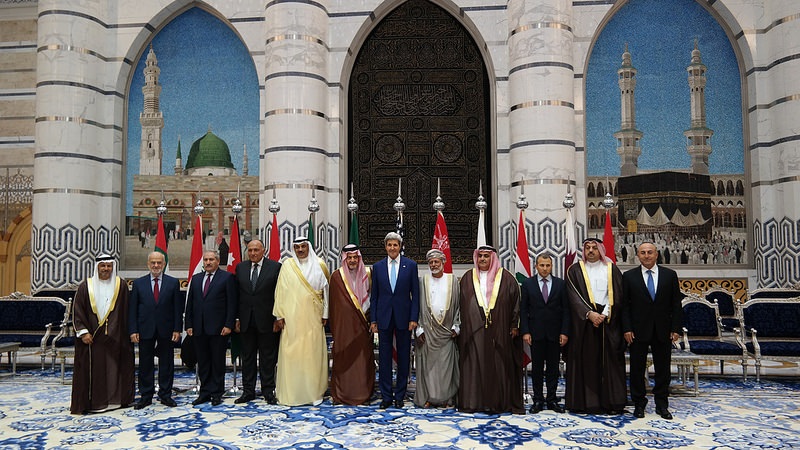
U.S. Secretary of State John Kerry poses for a photo with Gulf Cooperation Council (GCC) and Regional Partners meeting participants in Jeddah, Saudi Arabia on September 11, 2014. [State Department photo/ Public Domain]
The strategy of forming the Coalition of the Willing to militarily defeat IS has been criticized by Republicans in the United States as well as the top brass of the U.S. military. Evaluation of the strategy has not been conclusive. Nevertheless, the successful formation of the international encirclement network should be credited. While the Obama administration has been strongly criticized for allowing Syrian civil war to drag on endlessly, it regained some credibility through the formation of the Coalition of the Willing including Arab and Gulf countries.
The United States conducted more than 100 sorties in Iraq in August. On September 24, the first aerial bombings against four IS targets in Syria including command and control facilities in Raqqa which is the de fact capital of IS by fighters, bombers, drones and Tomahawk cruise missiles in joint operations with Middle Eastern countries such as Jordan, Bahrain, Saudi Arabia, Qatar and UAE.
The broad international encirclement network formed by more than 60 countries made it possible to achieve the international coordination to prevent and deter diffusion of Al Qaeda, IS, Islamic extremist groups and jihadists, encircle and contain their domain.
The U.S. military campaign against IS in 2015
This year, armed gunmen affiliated with IS attacked the French satirist weekly newspaper Charlie Hebdo and killed 12 people including two policemen, the newspaper’s chief editor, satirist cartoon editors and columnists. IS then committed murder by executing two Japanese hostages. IS subsequently committed shooting attack at a museum in Tunis, killing 20 people.
In Iraq, IS amassed its forces in Anbar Province in western Iraq and seized Ramadi. In Syria, IS seized Der Zor using Raqqa as the base and seized (2)Palmyra, a World Heritage site on May 14.
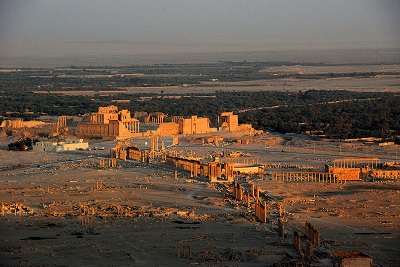
Overview of the Palmyra historic site (Wikipedia/Stobkcuf)
In response, the Iraqi government requested the United States’ support to regain Ramadi, and the United States decided to send additional 450 military personnel. They are stationed at the Iraqi military’s command post in the east of Ramadi and quickly organized posture to carry out aerial bombings while they are not involved in ground battles. The total number of the United States troops stationed there has reached 3,550. Ben Rhodes, White House Deputy National Security Advisor stated, “The best method to regain national territory is that Iraqis themselves fight in the front line,” and pointed out that the increase of the U.S. personnel does not represent a change of the existing strategy.
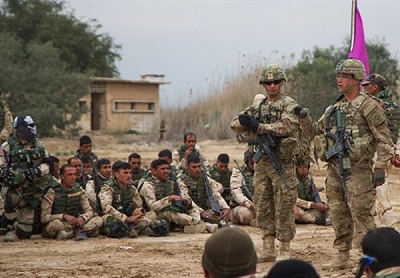
Iraqi army soldiers with 73rd Brigade, 15th Division, look on as U.S. instructors from the 3rd Brigade Combat Team, 82nd Airborne Division, discuss movement techniques and squad-level tactics at a training area on Camp Taji, Iraq, March 24, 2015. U.S. Army photo by Sgt. Cody Quinn
The Kurdish units reclaimed Tal Abyad, a town in the northern Syria near the Turkish border with air support from the U.S. forces. The town is located to the east of Ain al Arab controlled by IS and closer to Raqqa, the de fact capital of IS. It is also on the main IS supply line of fighters and materials to Raqqa. It is also on the oil smuggling route to Turkey and loss of the town is expected to cause major disruption to the funding for IS.
The coordination with the ground forces is the key to the effective aerial bombing operations. In the Kurdish autonomous region in the northern Iraq, many areas have been regained through good coordination with the Kurdish security force Peshmerga. On the other hand, the failure to coordinate between Iraqi ground forces and the U.S.-led aerial bombing operations was considered to be a major factor for loss of Ramadi, and additional 450 U.S. personnel were sent based on the lesson.
Battles are underway between Kurdish militias and IS in the north western Syria near the Turkish border. On July 4 and 5, the Coalition of the Willing conducted aearial bombardments in Raqqa and killed 30 people. Also, 100 Syrian rebel fighters completed their training in Turkey and are expected to be deployed in Syria soon.
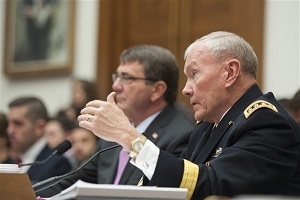
Chairman of the Joint Chiefs of Staff Army Gen. Martin E. Dempsey and Secretary of Defense Ashton Carter testify before the House Armed Services Committee in Washington, D.C., June 17, 2015. DoD photo by Navy Mass Communication Specialist 1st Class Daniel Hinton
It was reported that the “Southern Front” of the Free Syrian Army trained in Jordan expelled the Syrian government forces from Daraa which is a major Syrian military base In the southern Syria near the Jordanian border. Daraa is less than 100 km from Damascus.
Those developments indicate that the United States forces are successfully coordinating with the Kurdish forces and taking back areas from the control of IS. On the other hand, the United States forces’ coordination with Arab Sunni tribes is not going well, and this appears to be a reason why (3) the additional U.S. personnel were sent.
The Free Syrian Army, Syrian anti-government force, which keeps distance from Islamic extremism or jihad ideology, is increasing its capability through military trainings in Jordan, and making advance in the battle fields.
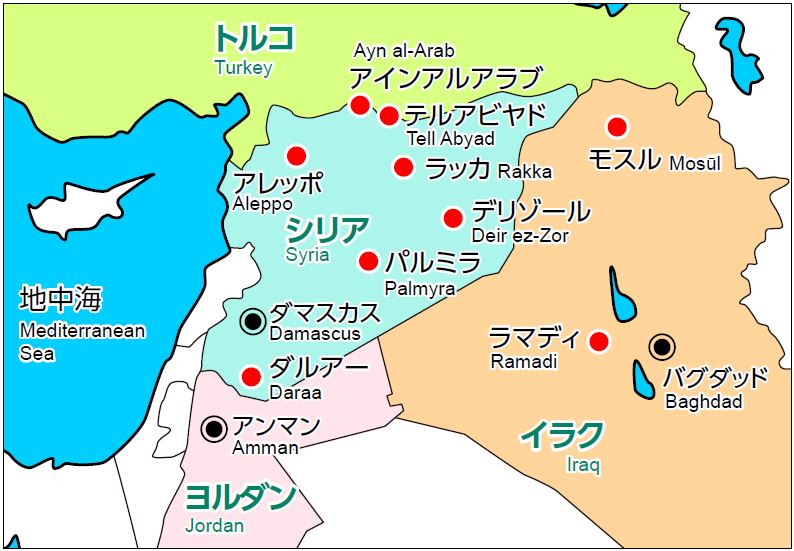
Decrease of IS fighters
The near-simultaneous terrorist attacks in three countries right before June 29 first anniversary of the declaration of establishment of IS may have been carried out under a direct order from IS or by (4) lone wolf terrorists influenced by IS. Although the nature of the attacks cannot be determined for sure, those incidents were caused directly or indirectly by IS without doubt.
Viewed from another angle, IS was preoccupied with their battles in Iraq and Syria and had no spare fighters to send to other countries. Besides, IS lost control over the border area between Syria and Turkey which has been the best passageway for fighters to go out of IS territories. It is assumed that the movement of IS fighters in and out of IS territories has been curtailed greatly as the result.
Recently, an intriguing article appeared, which reads, “A former extremist Egyptian man continues his desperate effort on the Internet to persuade fighters who joined IS and are active in Iraq and Syria to leave the group. His attempts are bearing fruits, and 50 Egyptians already left the group and returned to their country.” (Jiji Press, Alexandria, Egypt)
This news article reveals the fact which IS does not want to be known. That is because this fact will negatively impact on their efforts to recruit fighters using advanced IT technology.
The future challenges
The international society should continue the efforts to maintain encirclement against IS and cooperate with the operation to regain territories in Iraq and Syria from IS control.
It is also important for Muslims as a relevant party to speak out that “Extremist or jihadist ideology is deviation from the teachings of Islam” in order to testify that “Islam is a peaceful and moderate religion.”
It is hoped that such action on the part of Muslims can lead to solution with minimum sacrifices.
FootNote
(1) (four countries)
Terrorist attacks took place in four countries on June 26, but the attack in Somalia was carried out by the Al Qaeda-affiliated Islamic extremist group Al Shabaab. There appeared to be little involvement by IS in the attack.
“On June 26 (local time), the Burundi force base of the African Union Mission in Somalia (AMISOM) in Leego in the Lower Shabelle, about 100 km north-west of the capital Mogadishu, was attacked by the Islamic extremist group Al Shabaab and AMISOM suffered heavy casualties.” (Ministry of Foreign Affairs homepage) of the U.S. troops from Iraq in 2011. Because of this, it is in question whether the additional U.S. military personnel sent this time can re-establish friendship with the local Sunni tribes.
(2)Palmyra, a World Heritage
Palmyra is in danger of destruction by ISIL. Palmyra in central Syria is a historic city site of Roman Empire age, registered as UNESCO world heritage in 1980. Roman style rchitectures are many, such as theater in the round, bathhouse, and Tetrapylon. (Wikipedia)
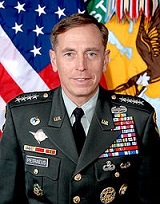
General Petraeus
(3) additional U.S. personnel
The “Awakening of Anbar” initiated by Sunni tribes with support from additional U.S. troops commanded by General Petraeus completely defeated the Al Qaeda of Iraq (the predecessor of IS) in 2006 and 2007. However,Sunni tribal chiefs were abandoned after complete withdrawal of the U.S. troops from Iraq in 2011. Because of this, it is in question whether the dditional U.S. military personnel sent this time can re-establish friendship with the local Sunni tribes.
(4) lone wolf terrorists (lone-wolf type terrorism)
Individuals plan and carry out terrorist attacks with support in a limited scope from siblings and relatives. After terrorist attacks were carried out, based on individual consciousness and the objective situation, they are found to have been inspired by Al Qaeda (or IS) … (cited from page 39 of “Impact of the Islamic State” authored by Satoshi Ikeuchi)
◆Palmyra, a World Heritage
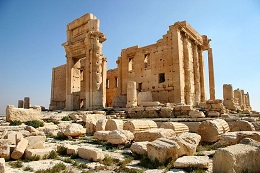
Temple of Bel in Palmyr(Wikipedia/Zeledi)
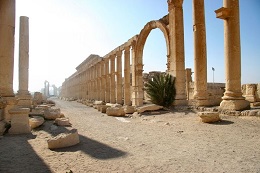
Palmyra, Syria, ancient Decumanus(Wikipedia/Zeledi)

Tetrapylon Palmyra(Wikipedia/Citypeek)

Panoramic view of the Roman theatre in Palmyra(Wikipedia/Eusebius)
More articles available in the electronic “Salaam Quarterly Bulletin”, No.15, August 2015.
